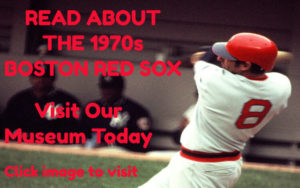The Seasonal Narrative Of The 1969 Boston Red Sox
The 1969 Boston Red Sox continued a pattern that had started the year before. They were a solid winning franchise, but replicating the out-of-nowhere pennant run of 1967 was going to require a big jump.
Boston had followed up the 1967 pennant–which came after a decade of really bad teams–by winning 86 games in 1968. The game changed significantly in 1969–expansion split the leagues into two divisions, East & West with a League Championship Series round instituted prior to the World Series. The pitching mound was lowered to enable an increase in offense. But amidst the changes the Red Sox remained essentially the same, winning 87 games with a team strong on offense and struggling with pitching.
Carl Yastrzemski was the cornerstone, and the 29-year-old Yaz anchored left field, hitting 40 home runs and driving in 111 runs. Reggie Smith, a 24-year-old centerfielder that was a package of power and speed, finished with an on-base percentage of .368 and a slugging percentage of .527. Ken Harrelson opened the season as the rightfielder, having led the team in RBI in 1968.
Shortstop Rico Petrocelli added to the production with a breakout year. Petrocelli hit a career-high 40 home runs, finished with a .403 on-base percentage, had 97 RBI and scored 92 runs. 1969 was the best year of a pretty solid career and Petrocelli finished seventh in the MVP voting.
Petrocelli’s middle infield partner Mike Andrews, a favorite of third-year manager Dick Williams, continued to be a solid presence, with a .390 OBP and some surprising pop, with 15 home runs. George Scott continued to grow into an offensive threat, hitting 16 home runs at third base.
But the big story of the season was the return of Tony Conigliaro.
“Tony C” was one of the bright young stars in baseball in 1967 when he suffered a terrible beaning in August of that pennant-drive year. This was before batting helmets had a flap on the side facing the pitcher and it shattered his eyebones. Congliario missed all of 1968 in recovery. His return in 1969 saw him start to come back. The numbers weren’t spectacular–a .321 OBP and .427 slugging. But even being on the field was a miracle and to produce at even this respectable level was an amazing testament to Congliario’s courage and persistence.
The pitching staff continued to be a problem. Ray Culp was reliable, winning 17 games and consistently taking his turn. But Culp wasn’t cut out to be an ace and Jim Lonborg’s second straight subpar year following his outstanding 1967 season and subsequent ski accident on Christmas Eve of that year continued to plague the staff.
An ill-advised trade early in the season didn’t help. Boston dealt away Dick Ellsworth to the Cleveland Indians, who was a similar pitcher to Culp–not great, but reliable. To make matters worse, the focal point of the deal was Harrelson. In return, the Red Sox got 32-year-old starting pitcher Sonny Siebert, basically indistinguishable from Ellsworth and reliever Vincente Romo, a reliever who finished with a 3.18 ERA.
Thus, what it boiled down to is that the Red Sox traded away one of their most productive bats for an above-average reliever while making no discernible improvement in the starting pitching.
Boston still started the season strong. They went 26-14 going into Memorial Day and were right on the heels of the red-hot Baltimore Orioles. The Birds were the only team the Red Sox couldn’t beat in the early days–a three-game series saw Boston pitching give up thirty runs to Baltimore. Even so, the Red Sox closed the month of May on an 18-6 run and were right in the thick of the first-ever AL East race.
It was the middle of June when Boston stumbled and it came at point in the schedule that should have been ripe for them to make up ground. They played 11 of 15 games at home and the opponents were the Oakland A’s, Cleveland Indians and New York Yankees. Only the A’s were a good team. Yet the Red Sox lost nine of the fifteen games and were suddenly nine games back of an Oriole team that just kept on rolling.
The margin widened to 13 1/2 games, but Boston would play Baltimore eight times in the final week and a half before the All-Star break. It was an imposing task, but if the Red Sox could win six games, they’d at least put the deficit back into single digits by the break.
Baltimore’s Memorial Stadium–the house on 33rd Street–as it’s called by the locals–was the venue for the first five games. The opener was tied 4-4 in the bottom of the ninth, but Romo–acquired at such great cost–surrendered a walk, a stolen base and an opposite field single to Frank Robinson that ended it.
The Red Sox stiffened their spine for Friday’s doubleheader. The opener was tied 3-3 in the seventh, when Yaz homered to get the lead and Smith drilled a three-run shot in the eighth to put away a 7-4 win. Andrews was the hero of the nightcap, going 5-for-5 in the leadoff spot and the Sox coasted to a 12-3 rout.
Conigliaro came out on Saturday against Baltimore’s Mike Cuellar and got three hits. Tony C was the only one in the lineup that got a hit though, and Cuellar spun a 4-0 shutout. In a virtual must-win game on Sunday, Lonborg couldn’t get out of the second and the Red Sox had lost three of five in a series they needed to dominate.
The three-game set to close the first half went better, as Andrews hit a first-inning home run to lead a 6-1 win in Friday’s opener. On Saturday, Yaz hit a game-tying home run in the sixth to make the score 3-3 and then first baseman/backup catcher Dalton Jones hit a two-out, two-run double in the seventh for the run that stood up.
In Sunday’s finale, the Sox were leading 3-2 when Boston backup infielder Syd O’Brien ripped a two-run triple. Lonborg, on in relief in the era prior to the DH, hit a sacrifice fly. That run was necessary, because Longborg nearly gave it all back in the ninth, being charged with three runs. Sparky Lyle came out of the bullpen to get Brooks Robinson and close the 6-5 win.
Boston had won five of the eight games with Baltimore, although with the margin still at 12 1/2 , it smacked of too-little too-late. And that proved to be accurate.
The Red Sox did not win another series until the middle of August, by which point the deficit was 21 games and the Orioles were off and running to a 109-win season, so no one was going to catch them in any case.
Unfortunately, this was also the year the Dick Williams era came to an end. In spite of turning the franchise around immediately, Williams’ prickly personality got him canned with nine games to go. Boston ended up in third place.
The Red Sox continued to be good without Williams, steadily producing winning seasons. But Williams did even better for himself–he went to Oakland and led a team that would be the great dynasty of the 1970s.


